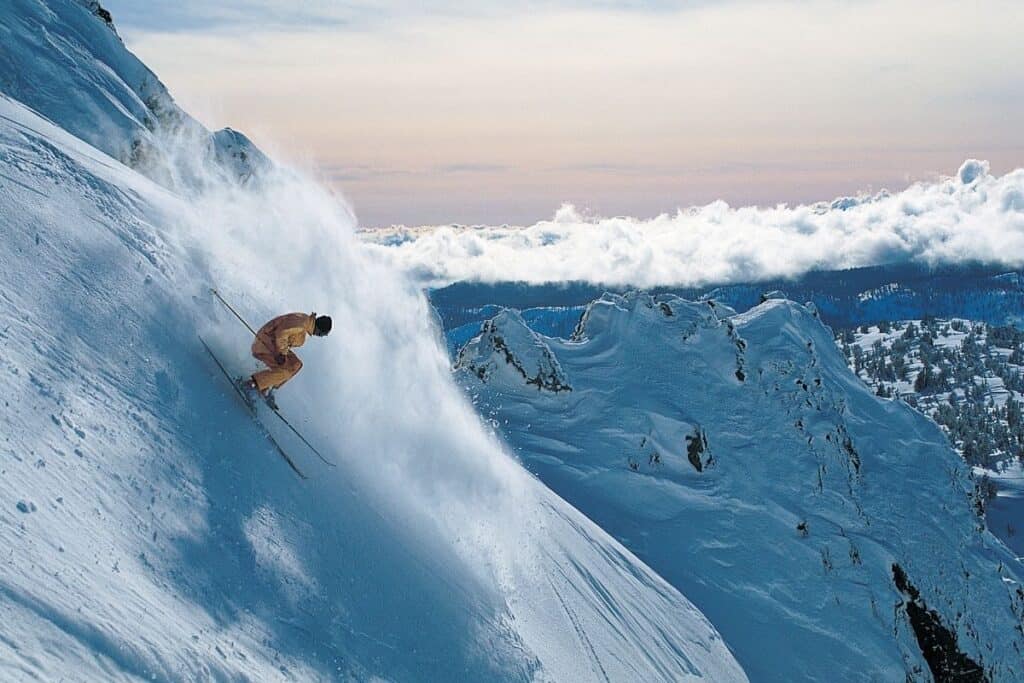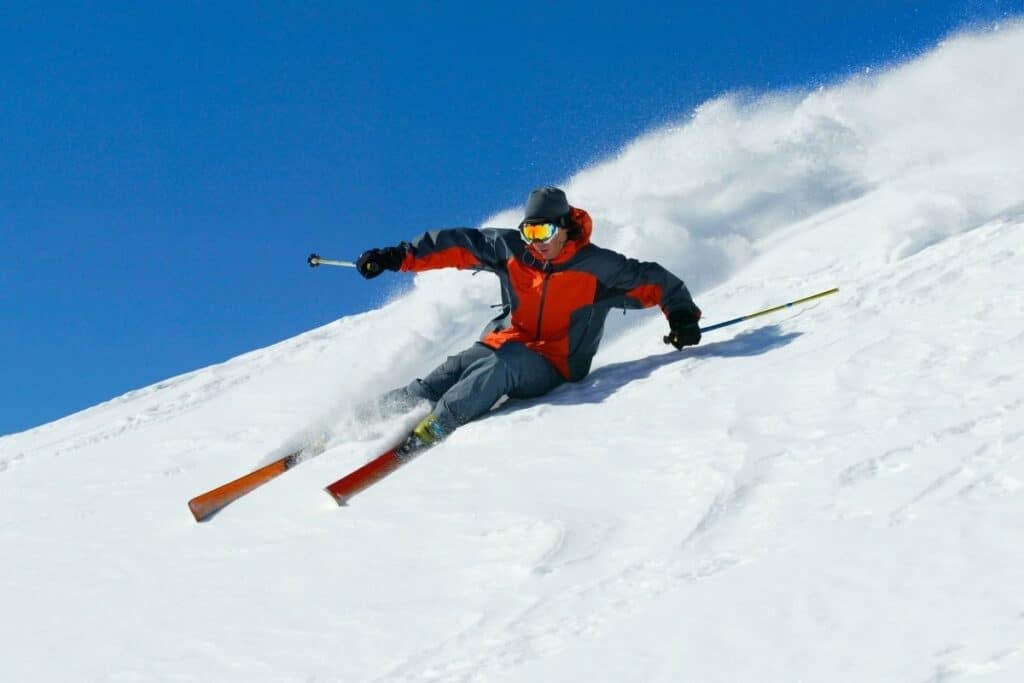
Some of us aren’t daredevils. When we go out for a day on the slopes, we want to have a fun time and keep all of our bones intact! Then again, others may like a challenge and a shot of adrenaline along with it. These people may be wondering- is skiing an extreme sport?
Skiing can be an extreme sport, depending on how you do it. However, unlike extreme sports such as skydiving or freestyle mountain climbing, the risk level can vary greatly depending on the terrain, with freestyle skiing being the most extreme.
Now you might be asking yourself- what’s the difference between freestyle and regular skiing? How can I stay away from the more hardcore stuff or- possibly- get into it? This article will answer all of your questions and more.
When is Skiing an Extreme Sport?
First, let’s look at what we mean by ‘extreme sport’ – an extreme sport is one that occurs under conditions of high risk or speed. Examples of extreme sports include BMX racing, skydiving, and freestyle skiing.
In general, there’s a much greater risk for injury or death in extreme sports because of the uncontrolled environments.
In these environments, safety measures are of the utmost importance. Helmets and other forms of body protection are commonly used in these sports for added protection.
As you could probably guess, skiing can become an extreme sport depending on how and where you do it. For example, if you’re reaching top speeds in a wooded area or other backcountry, you’ll have much more obstacles and much greater risk.
Risks on backcountry slopes include avalanches, ravines, and protruding rocks that can seriously injure or kill skiers if they collide with them. In all of these settings, skiing can be considered an extreme sport.
However, the style of skiing most often considered ‘extreme’ is called freestyle skiing.
Freestyle skiing occurs when a skier attempts to do tricks and other impressive feats while skiing. Freestyle skiing often involves rails for grinding, half-pipes for aerial stunts, and large jumps. This skiing style is also an event in the winter Olympics, so it is considered an accepted and professional mode of skiing.
The idea in freestyle skiing is for skiers to mimic the kinds of tricks and stunts that skateboarders do. It’s a high-intensity, high-risk way to ski, but one that can provide a lot of adrenaline and excitement to skiers who want a challenge.
In most cases, skiing is a relaxing activity that provides good exercise and fun for people of all ages. If you don’t like a high-risk, high-speed environment, just hit the slopes. There are bound to be less steep hills for beginners or people who just want a relaxing skiing day.

How Risky is Skiing?
According to sloperunner.com, if you ski a thousand days, you can expect only one to two injuries, which isn’t so bad. Having a serious injury while skiing is somewhat unlikely and can be prevented.
However, just like with any sport, skiing is not without some risk. A friend of mine recently went skiing and tore a muscle in her leg. She had to have surgery and couldn’t run, jog, play sports, or lift weights with her legs for a few months.
Head injuries can also pose a threat to skiers looking to protect life and limb on the slopes. Head injuries often result in hospitalization and can even cause death and disability. To reduce the severity of this threat, wear a helmet.
Sprains are also a pretty common problem for skiers. When you’re going at high speeds, those long skis at the ends of your legs can act as powerful levers, wrenching your feet in awkward directions.
To reduce this risk, you can simply work your way up to harder and harder slopes.
Don’t bomb a steep slope on your first go- throwing yourself into the deep end will only create problems. Start on the kiddy hills if you have to, and only move up when you’re comfortable!
Backcountry skiing, or skiing in less controlled environments and terrains, can be an extremely risky experience. I’ve encountered downed trees, hidden ravines, creeks buried in snow, and all other manner of nasty obstacles in my backcountry skiing experiences.
Whether by skill or sheer luck, though, I’ve managed to avoid any severe injuries up to now (fingers crossed that it stays that way!).
There’s no way to remove these obstacles while backcountry skiing. If there were, backcountry skiers wouldn’t exist. We’re looking for the excitement and the danger, and if you are too, you might want to try it.
The only way to keep yourself safe while doing this kind of skiing is to keep your eyes peeled and your head on the swivel- as much of a swivel as possible in your big helmet, at least.
Threats will can come from anywhere in backcountry skiing. You’re just going to have to listen to the land and pay attention to your surroundings!
How to Start Skiing
Starting skiing safely can be quite a challenge. Knowing all the risks, you might be tempted to just stay at home on a white winter day. Don’t. Skiing is such a fun experience, and I can’t recommend it enough. Ask any other skier, and they’ll say the same.
If you want to stay safe and sound as a beginner, you can hire an instructor or attend a group skiing class – if there’s one in your area. Instructors usually only cost around $35-$50, and you’ll only need about an hour or two of tutoring to pick up the basics.
A class can also be a great way to learn to ski – especially if you’re a social person. Skiing classes are very opportune places to meet some new friends!
If you’re an independent person or just don’t like interacting with strangers too much, you also might try going out on your own. So long as you pace yourself and make sure you’ve got all the right gear, you should be fine.
Remember that a ski instructor will know a few tips and tricks and a few do’s and don’ts that won’t be too obvious to a beginner. Of course, a quick search on the internet will reveal everything you need to know about the subject and a lot more.
Lastly, you might be smart to take a buddy along. Even if they’re not skiing themselves, they could watch you as you attempt your first few trips downhill (just start on the bunny slope!).
Like having a spotter while weightlifting, having someone to get you out of a precarious situation is always a good thing. Just don’t let their presence discourage you from trying your best.
Ask resort employees about the local slopes and trails and see which one is right for you. Usually, resorts have helpful and knowledgeable staff on hand to tell skiers what they might want to do, which slopes they might like to go on, and which areas are recommended for which skill levels.
Skiing Gear for Safety
There are a couple of pieces of gear you can bring along to make sure your trip is safe and fun and a couple of things you can do to keep yourself intact!
For one, never doubt the power of a helmet in reducing the severity of a head impact (which will, at some point, occur).
Helmets increase the amount of time an impact takes to happen, thus reducing the hit’s overall force. They also shield delicate flesh from hard, abrasive surfaces like exposed rocks.
Secondly, a good pair of goggles can reduce the likelihood of an accident. Though they might seem like a relatively simple and unnecessary tool- just for keeping the sun out of your eyes- they are a necessary part of every skier’s arsenal.
When things start to heat up, and your speed starts to increase, you’ll want to avoid any and all distractions. This includes glare from the snow, which can be like looking into a second sun. Your eyes will also water as the wind picks up, which can temporarily blind you.
Finally, and this is something many skiers fail to consider, you’ll want to get your bindings professionally fitted to your skis before doing any serious skiing.
Improperly fitted bindings are an imminent danger to your ankles and legs, as they might wobble and reduce your balance. You can also fit your ski bindings yourself, but it might be a little tricky, depending on how much experience you have.
All in All
All in all, skiing is not necessarily a dangerous activity, but it can be considered an extreme sport. There are ways to stay safe while skiing and gear you can buy to reduce risk.
If you want more extreme experiences, try backcountry and freestyle skiing. For something more tame, try alpine downhill.
Related Articles
If you found this article helpful, then make sure to take a look at some of my other related articles linked below!
